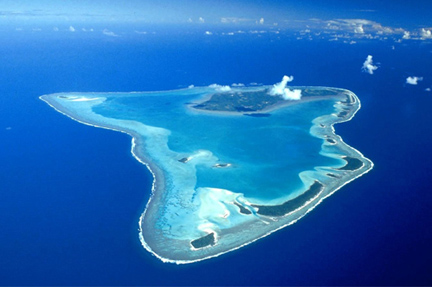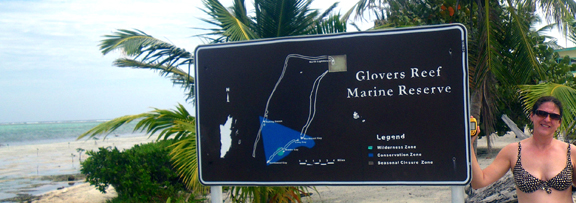Glover’s Atoll Earthcache
What is an Atoll?
Atolls are islands of coral reef that encircle a lagoon
partially or completely. They are circular, oval or horseshoe in
shape, and the central lagoon is shallow. The small islands of
coral reef are broken by channels that lead from the sea into the
central lagoon. Viewed from above, it looks like a flat ring of
sandy land with a shallow pool (you can see the color of the water
change) in the center.

Atoll Formation
Charles Darwin was one of the first people to think about how
coral atolls were formed and his “subsidence theory of coral reef
formation” has received empirical support. In 1842, based on his
observations of atolls in the South Pacific, Darwin concluded that
these unique land creations were a result of two factors that
occurred simultaneously – coral reef growth and the gradual sinking
of an oceanic island.
The process of atoll formation takes as long as 30 million
years. An atoll is thought to begin as living corals colonize and
build a fringing reef around the flanks of a seamount or volcano.
Over hundreds of thousands of years, as the volcano cools and
becomes denser, it gradually sinks below the sea surface. The
corals, whose symbiotic algae require light to grow, continue to
build the reef upward towards the sea surface, maintaining the top
of the reef in the photic zone. New corals grow on top of older or
dead ones, and the process continues as the volcanic island begins
to sink. Over time, the reef gradually becomes separated from the
subsiding island by a lagoon, thus forming a barrier reef.
Eventually the cold volcano sinks so far that it disappears beneath
the surface, leaving behind the characteristic ring-shaped reef
surrounding a central shallow lagoon. Eventually, due to wind and
wave erosion, corals break into pieces and become sandy, creating a
land surface called a caye (pronounced “key”).
Thus, atolls are built on thick layers of dead coral reefs.
Scientists have drilled over 1400 m through coral limestone before
striking volcanic rock on Pacific atolls, supporting Darwin's
hypothesis that atolls develop as fringing reefs subside.

Location Background
Located off the coast of Belize, the Mesoamerican Barrier Reef
is the largest coral reef system in the Western Hemisphere.
Situated at the southern most end of the Belize Barrier reef
approximately 28 miles offshore is Glover’s Reef Atoll, named after
pirate brothers, John and Rodger Glover, in the1750's. It is an
oval-shaped atoll measuring approximately 20 miles long and 7 miles
wide.
At a glance, Glovers Reef is composed of a deep lagoon studded
with about 850 patch reefs and pinnacles rising to the surface, six
sand cays located on the reef crest along the southern edge, and a
peripheral reef broken in three places by deep channels. Glovers
Reef has three main habitats; the lagoon floor, the peripheral
reefs and the patch reefs, and is recognized as the most
biologically developed atoll within the Belize Barrier Reef.
The posted coordinates take you to the Glover’s Reef Marine
Reserve. There is a dock at the coordinates, and visitors are
welcome during daylight hours.

To Log this Earthcache you need to complete the following
tasks:
- Take a photo of yourself holding your GPS at the coordinates
with the sign in the background. Post your photo with your
log.
- Send me an e-mail with the answers to the following
questions:
(1). On your way to the coordinates, observe the conditions as you
come through the coral wall into the lagoon. Estimate the width of
the coral wall above sea level, and the depth of the lagoon as you
cross over from the open sea.
(2). At the coordinates, observe the ground below you. Describe the
materials you find in the sand here (color, consistency,
identifiable items within it).
Sources:
Wildlife Conservation Society (http://wcsgloversreef.org/)
Ocean (American Museum of Natural History), P. Eales, D. Burnie, F.
Dipper.
The Voyage of the Beagle, Charles Darwin
Atoll, The Encyclopedia of the Earth
(http://www.eoearth.org/article/Atoll)
Atoll, Wikipedia (http://en.wikipedia.org/wiki/Atoll)
Atoll, Dictionary
(http://dictionary.reference.com/browse/atoll)